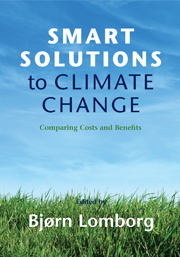Book contents
- Frontmatter
- Contents
- List of figures
- List of tables
- List of contributors
- Acknowledgments
- List of abbreviations and acronyms
- Introduction
- PART I THE SOLUTIONS
- 1 Climate Engineering
- 2 Carbon Dioxide Mitigation
- 3 Forestry Carbon Sequestration
- 4 Black Carbon Mitigation
- 5 Methane Mitigation
- 6 Market- and Policy-Driven Adaptation
- 7 Technology-Led Climate Policy
- 8 Technology Transfer
- PART II RANKING THE OPPORTUNITIES
- Conclusion
- Index
- References
3 - Forestry Carbon Sequestration
Published online by Cambridge University Press: 05 June 2012
- Frontmatter
- Contents
- List of figures
- List of tables
- List of contributors
- Acknowledgments
- List of abbreviations and acronyms
- Introduction
- PART I THE SOLUTIONS
- 1 Climate Engineering
- 2 Carbon Dioxide Mitigation
- 3 Forestry Carbon Sequestration
- 4 Black Carbon Mitigation
- 5 Methane Mitigation
- 6 Market- and Policy-Driven Adaptation
- 7 Technology-Led Climate Policy
- 8 Technology Transfer
- PART II RANKING THE OPPORTUNITIES
- Conclusion
- Index
- References
Summary
Introduction
There is widespread belief now that forests can be used to reduce the costs of slowing climate change. While the role of forests in the global carbon cycle has long been acknowledged, recent discussions within the context of the United Nations Framework Convention on Climate Change (FCCC), as well as efforts to write climate change legislation in the USA, have emphasized the role forests might play. The most recent policy efforts have focused on near-term actions to reduce deforestation in tropical countries.
The rationale for considering forests at all in the policy mix stems partly from the physical components of the issue. The world's forest estate is exceedingly large: It contains roughly 3.9 billion ha of forestland and 1 trillion tons of CO2 (UN Food and Agricultural Organization 2006). Current estimates indicate that roughly 11 million ha each year are lost in tropical regions due to deforestation and conversion of land to agriculture (Houghton 1999, 2003). These losses cause emissions of about 3.6–4.5 billion tons of CO2, so that deforestation accounts for around 17% of global carbon emissions. Countries like Indonesia and Brazil are near the top of total emissions when estimated by country if deforestation is included in carbon emission calculations. Efforts to slow these emissions, of course, could have enormous benefits for society.
- Type
- Chapter
- Information
- Smart Solutions to Climate ChangeComparing Costs and Benefits, pp. 114 - 141Publisher: Cambridge University PressPrint publication year: 2010
References
- 13
- Cited by



